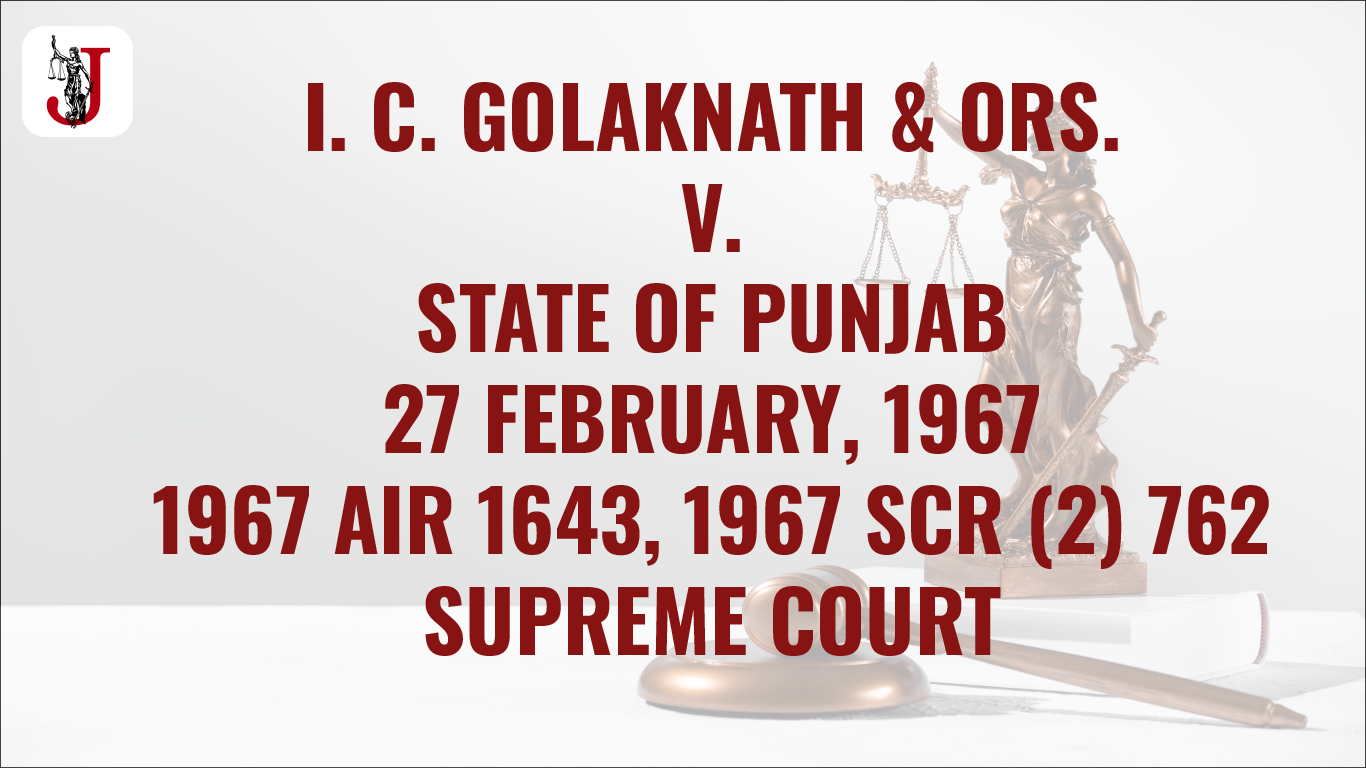1967 AIR 1643, 1967 SCR (2) 762
Introduction
The Zamindari system was a major social issue after independence. The government failed to eliminate it due to Article 19(1)(f) of the Constitution, which provides property rights as fundamental rights.
The 1st Amendment Act was passed by the parliament, which limited the Right to Property under Article 19(1)(f). The government can acquire anyone’s property to balance the socio-economic status of society, along with the 9th Schedule, where it is said that if any law is passed under this schedule, then it cannot be challenged in court. The 9th Schedule mainly focused on the land reformation. The Punjab Security and Land Tenure Act, 1953, was one such law that was added to the 9th Schedule by the 17th Constitutional Amendment.
Fact of the Case
- The family of Henery and William Golaknath had over 500 acres of land in the state of Punjab.
- The State government, under the Punjab Security and Land Tenure Act, 1953, says that they can keep only 30 acres of land, and the rest will be distributed among the workers on the field for their welfare.
- Golaknath’s family and others file a Writ petition under Article 32 of the Indian Constitution with the Supreme Court and say that the law violates their fundamental rights under Article 19(1)(f), i.e., the right to hold and acquire property; 19(1)(g), the right to practice any profession; and Article 14: equality before law and equal protection of laws.
- The petitioner argued that the Constitution of India was drafted by the constituent assembly and is of a permanent nature; no one has the power to change or can try to bring about change in the Constitution of India.
- They also argued that Article 368 of the Indian Constitution only mentions the word “procedure” for “amendment”; there was no actual power given to the parliament for amendment.
- Hence, they pleaded to declare the Punjab Security and Land Tenure Act, 1953, under the 9th Schedule as ultra vires.
Issues
1. Is an amendment a law or not?
2. Whether the parliament has the absolute power and the power to amend the fundamental rights enshrined under the constitution or not?
Judgement
- This judgment reversed the Supreme Court’s earlier decision, which had upheld Parliament’s power to amend all parts of the constitution, including Part III related to the Fundamental Rights.
- The judgment left Parliament with no power to curtail fundamental rights.
- This case was decided by the Eleven Judges Bench of the Supreme Court, where six justices were in favor of the petitioner (the majority) and five justices were against the petitioner.
- The majority decision held that a constitutional amendment under Article 368 of the constitution was an ordinary “law” within the meaning of Article 13(3) of the constitution. Hence, if an amendment “takes away or abridges” a Fundamental Right conferred by Part III, it is void.
- Therefore, to save the democracy from the autocratic actions of the parliament, the majority held that parliament cannot amend the fundamental rights enshrined under Part III of the Constitution of India, and this power would be only with a Constituent Assembly.
Doctrine of Prospective & Overruling
- In this case, Chief Justice Koka Subba Rao first invoked the doctrine of prospective overruling. Earlier decisions made by the Supreme Court were smart and better moves by the judiciary.
- The doctrine of prospective overruling implies that the effects of the law or judgment will be applicable on future dates; past decisions will not be affected by this decision.
Conclusion
This judgment forbids the parliament to cause further damages to the fundamental rights of the citizens.
The Parliament, in order to overrule the decision laid down in the Golaknath’s case, passed the 24th Amendment Act in 1971 and made significant changes to Art. 368 and Art. 13.
The Parliament also replaced the word ‘Procedure’ with ‘Power’ to Article 368 of the Indian Constitution.
Youtube facebook whatsapp web weather translate google amazon gmail google translate Instagram cricbuzz traductor Hotmail restaurants satta king tiempo twitter googel maps Yandex Sarkari result clima hotels fb yahoo maps chatgpt yahoo mail weather tomorrow Netflix roblox nba wordle tradutor livescore premier league ibomma speed test canva pintrest outlook Instagram login omegle flipkart myntra paypal paytm Alibaba ebay lottery sambad linkedin tiktok shein bbc news real madrid gmail login Walmart ikea cricket snaptik flashscore English to hindi twitch google scholar Barcelona Sarkari Naukri matrimonial shadi lgbtq third gender woman children Advocate barrister vakil supreme court high court commissioner exams ll.b ll.m ugc net law ph.d. m.b.a. graduation degree certificate school additional session judge civil judge justice jurists crime criminology punishment capital sentence death warrant fine constitution of india criminal procedure code civil procedure code evidence act sale of goods act arbitration act all india bar exam lower judiciary higher judiciary additional district attorney contract act amendment act u.s. constitution Canada p r section article schedule judgment vacancy post Porsche louis Vuitton chanel Gucci Hermes dior cartier rolex titan tiffany & co Ferrari estee lauder coach lancome burberry prada omega yves saint Laurent Lamborghini ray-ban Armani Moncler tata reliance Givenchy celine Bentley tag Heuer sk-II can cleef & arpels bulgari Shangri-la lao feng xiang dabur baidyanath cipla birla monte carlo loewe rolls-royce bottega-veneta jaege-leCoulture Maserati valentino dolce & gabbana Salvatore Ferragamo sulwhasso tom ford Maruti Suzuki Hyundai kia intercontinental Tissot aston martin ysl beauty fendi Versace kenzo la mer longines gold price sensex human rights pollution
